Do you love hanging plants? I know I do. I can never have enough. They add so much beauty to your home and garden without much work. If you are interested in learning more about hanging plants outdoors or indoors, you have come to the right place.
Below are 40 Australia hanging plants that will liven up your home.
More...
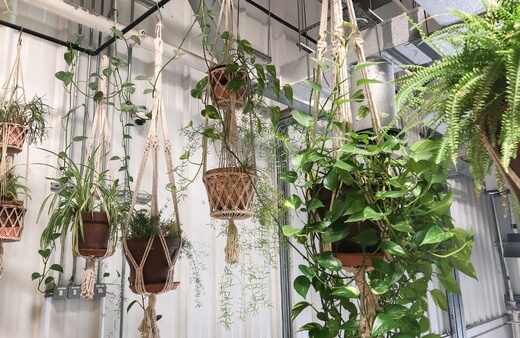
What to Look for When Choosing Hanging Plants
Just because you like the looks of certain hanging plants does not mean they are the right choice for your home. Before you purchase your new hanging plants take into consideration:
Sun or Shade?
Where will you be placing the hanging plants? Will they receive full sun, partial sun and shade, or full shade? Look for plants that will thrive in your lighting.
Do You Have Pets?
Some plants are toxic to pets. If you have any pets, do not purchase a plant that can harm them.

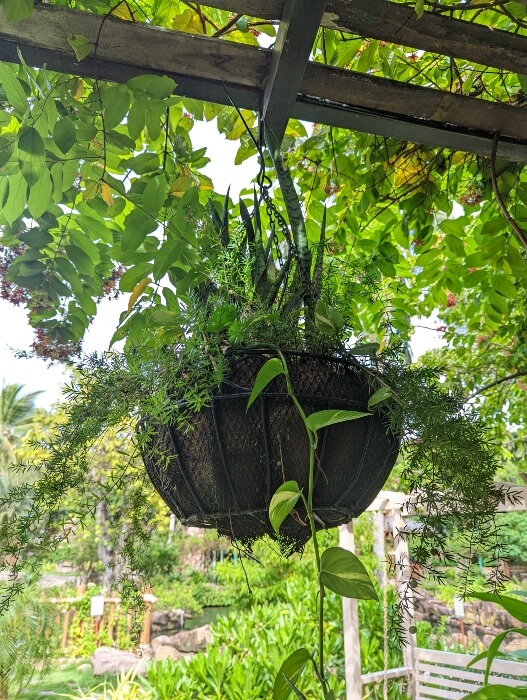
Cascading, Vining, or Full?
What types of hanging plants do you want? Do you want plants that cascade beautifully over the side of the basket? Are you interested in vining plants? How about plants that get full and are covered in flowers?
Indoors or Outdoors?
Do you want to display hanging plants indoors or outdoors? Some plants can grow in both conditions. However, most should be grown either indoors or outdoors.
Care
How much care does the hanging plants need? Are you willing to put the time and effort into keeping the plants alive? If you do not have much time to dedicate to your hanging plants, look for easy-to-grow plants that require very little care.
40 Hanging Plants in Australia
1. String of Turtles (Peperomia prostrata)

String of Turtles is also known as Jade Necklace. It is a semi-succulent plant that is perfect for hanging baskets. The plant is extremely easy-to-grow and is adaptable to a wide range of growing conditions.
String of turtles should only be grown indoors. This hanging plant does not grow well in direct sunlight. Instead, it needs filtered light. String of turtles prefer gritty, well-drained soil. Overwatering can cause the plant to rot. If the leaves are pale and lose their pattern, the plant needs more fertiliser.
2. String of Pearls (Senecio rowleyanus)

String of Pearls is also known as String of Beads. It is a succulent plant that works great in hanging baskets. It is an easy plant to grow. The hardest part about caring for the plant is breaking the delicate stems.
String of pearls can be grown indoors and outdoors. If grown outdoors, make sure it does not get direct sunlight. Too much can burn the plant and stress it out. If grown indoors, make sure it gets plenty of light.
String of pearls should be grown in a cactus and succulent mix soil. This hanging plant requires very little water. Overwatering can cause the plant to rot. The plants seem to do best when a slow-release fertiliser is added.
For more on succulents, see our list of the most grown succulents in Australia.


Get Your Free Guide:
Master Growing Australian Natives eBook
A Must Have Complete Guide for Every Australian Garden
Get Your Free Guide:
Master Growing Australian Natives eBook
A Must Have Complete Guide for Every Australian Garden
3. Lamium maculatum ‘Orchid Frost’
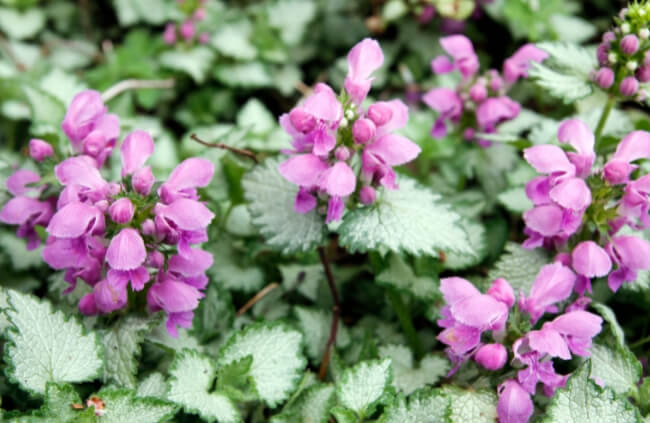
Lamium ‘Orchid Frost’ is a tough, ornamental evergreen. It is often used as a groundcover, but also looks great in hanging baskets. The plants have heart-shaped, silvery leaves that are edged in green. The plant produces lilac pink flowers from late spring through to autumn.
Lamium ‘Orchid Frost’ should be grown in outdoor hanging baskets. It will grow in full sun to full shade. It requires very little pruning and is frost tolerant. Lamium ‘Orchid Frost’ will grow in moist, well-draining soils.
This hanging plant requires a moderate amount of water. The soil should not be allowed to dry out. Slow-release fertiliser is recommended.
4. Swiss Cheese Plant (Monstera adansonii)

The Swiss cheese plant has only been available since 2016. And it has quickly become a fan favourite. It has long stems and small heart-shaped green leaves. Each leaf has a unique hole pattern.
The plant can trail over the side of the basket. Or you can add structures for it to climb. Swiss cheese plants can be grown indoors or outdoors in a shaded area. Light pruning is required from time to time to tame the plant and produce thicker vines.
Swiss cheese do not need direct sunlight. This hanging plant should be planted in soil rich in organic matter. Apply a slow-release fertiliser every 6 weeks.
5. Watermelon Pellionia (Pellionia pulchra)
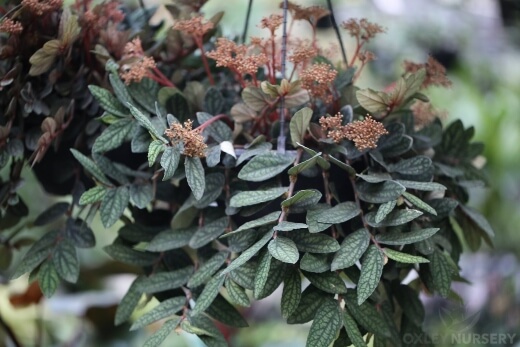
Source: Oxley Nursery
Watermelon Pellionia is known by many names including Watermelon Begonia. However, it is not a begonia or pilea. Instead, it is a member of the stinging nettle family. It is extremely easy to grow and hardy. The leaves are patterned and colourful. The plant produces small white flowers.
Watermelon Pellionia grows best indoors in partial sun to shade. It needs occasional tip pruning to produce a thicker plant. Watermelon Pellionia need rich, well-drained soil. When grown in partial sun, it will need moderate watering.
When grown in the shade, this hanging plant requires more water and produces bigger leaves. Feed Watermelon Pellionia every week throughout the growing season using a weak fertiliser.
6. Acalypha reptans ‘Stephie’

Source: Grow Master Heatherton
Acalypha 'Stephie' is fairly easy to grow with proper watering and fertilising. The leaves are a beautiful evergreen colour. The plant produces bright red, fluffy flowers that can grow up to 10 cm long.
Stephie can be grown indoors or outdoors. It requires full sun. The plant requires an occasional pruning to shape. Stephie grows best in moist well-draining soil rich with humus or peat moss. When grown in a pot, it needs to be fertilised regularly.
7. Tassel Fern (Huperzia spp.)

Tassel ferns are moderately easy to grow. They do not have flowers or fruit. Tassel Ferns can be grown outdoors or indoors in full shade. They will not survive if placed in direct sunlight.
During the growing season, fronds should be cut back to encourage new growth and prevent pests. Tassel Ferns will only grow in shade areas. Plant in an open bark mix soil. Styrofoam or coarse perlite can be added to the soil. Tassel Ferns generally require daily watering.
8. Busy Lizzie (Impatiens walleriana)
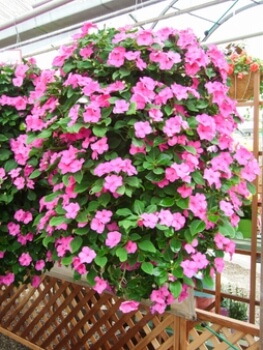
Busy Lizzies are easy to care for. They have glossy light-green foliage and showy blooms. The blooms can vary from whites and pinks to reds, purples, and oranges. Busy Lizzie should be grown outdoors.
This hanging plant requires plenty of sun with some light shade. Once the impatiens reach 25 cm tall, they should be pruned to encourage the plant to get full. Spent blooms and dead foliage should be removed regularly.
Busy Lizzies need morning sun and partial shade during the afternoon hours. They require a rich loam soil that is well-draining. The soil should be kept moist. If it dies out, the plants will quickly wilt. Busy Lizzies can be fertilised every two months throughout spring and summer.
9. Million Bells (Calibrachoa)

Million bells make perfect hanging basket plants. They are compact, low growing plants that spread and spill beautifully. They are extremely easy to care for. There are many varieties of million bells that flower in a wide range of colours.
Million bells are outdoor hanging plants. They are a tender perennial that will provide colour to your garden for months. They should be placed in an area where they will get direct sunlight.
Million bells should be planted in a well-draining, organically rich potting mix. The plants require regular watering. The soil should be kept moist at all times. Since the plants produce a multitude of blooms, fertiliser ought to be applied every 2 weeks.
10. Devil’s Ivy (Epipremnum aureum)
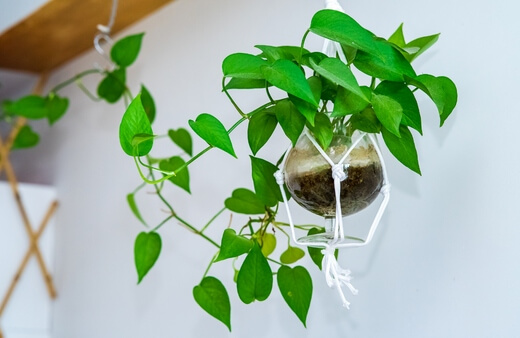
Devil’s Ivy has an abundance of green, glossy, marbled foliage. The leaves have an attractive heart shape. When grown indoors, Devil’s Ivy rarely flowers. If grown outdoors, it can produce purple to green spathes.
Devil’s Ivy is great for indoor and outdoor hanging baskets. It requires filtered to bright light. Devil’s Ivy grows best in a well-draining, light, porous, aerated soil. The soil should be kept moist, but the surface should be left to dry out between watering. A controlled-release fertiliser should be applied every month.
11. Verbenas (Verbena hortensis)
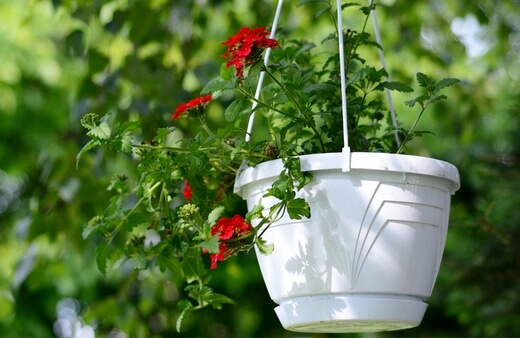
Verbenas are colourful hanging plants with small bluish green to bright green leaves. It is easy to maintain. The plant produces clusters of vibrant flowers in shades of white, pink, red, and purple.
Verbenas are outdoor hanging plants. In cooler climates they should be placed in full sun. In warmer climates, they need semi-shade. Verbenas need to be planted in a well-draining, fertile soil that is mixed with organic material.
The plants require regular watering when flowering. They can withstand dry periods and should not be overwatered. Fertilise yearly in the spring with a long-term slow-release fertiliser.
12. Rock Daisy (Brachyscome angustifolia)

Rock daisy are low spreading perennial with thin, linear leaves. This hanging plant does not require much attention. It has violet, daisy shaped blooms that are visible for many months out of the year.
Rock daisies are for outdoors hanging baskets. They need full sun to semi shade. Dead head the plants to encourage more flowers. Rock daisies prefer moist soil. A small layer of mulch will help keep moisture in. During the spring, a slow-release fertiliser should be applied.
13. Dichondra argentea ‘Silver Falls’
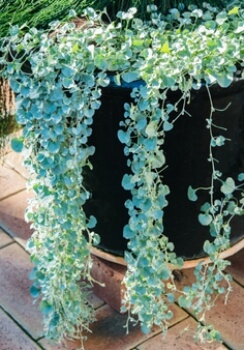
Dichondra ‘Silver Falls’ cascades beautifully over the sides of a hanging basket. It has silvery-green, creeping foliage with a striking appearance. It is a low-maintenance plant that is very popular.
This cultivar can be grown indoors and outdoors. It tends to do best in full sun. Stems should be pinched back every 7 days to encourage new growth. Overcrowded leaves need to be removed to prevent mildew and southern blight.
Dichondra ‘Silver Falls’ does not grow well in wet soil. Use a well-draining potting mix or gritty compost. The plants can tolerate mild droughts. Water the plants weekly but let the soil dry out first. Dichondra ‘Silver Falls’ should be fertilised every 2 weeks during the growing season.
Here's our in-depth guide to growing Dichondra ‘Silver Falls’.
14. Ivy Pelargoniums (Pelargonium peltatum)
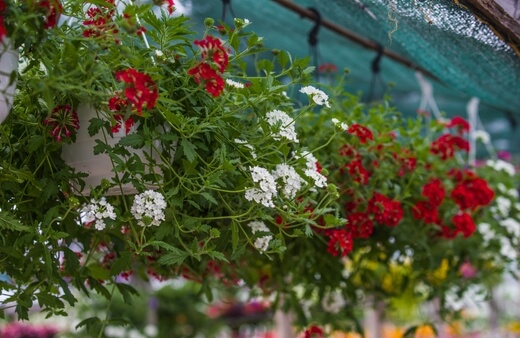
Ivy pelargoniums have dense, ivy-shaped foliage that can range from mid-green to dark green. The plants produce clusters of flowers in various shades depending on the variety. The main flowering period is from spring through early summer. However, some varieties produce flowers all year.
Ivy pelargonium hanging plants should be grown outdoors in all-day shade. They can tolerate a little bit of morning sun. They benefit from occasional, light pruning. Ivy pelargoniums prefer a well-drained medium moisture soil. They are not heavy feeders, so they only require a yearly feeding.
15. Petunias (Petunia × atkinsiana)
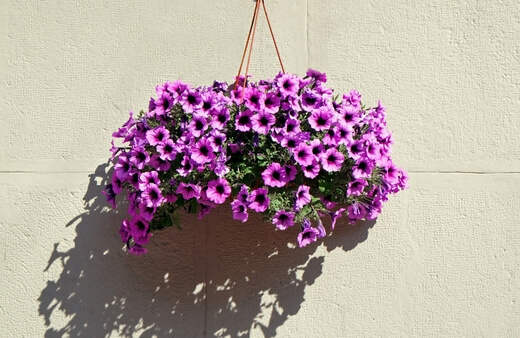
Petunias are mounding plants with branching foliage and wide, trumpet-shaped flowers. They can have striped, spotted, veined, solid, or bi-coloured flowers. Petunias must be grown outdoors.
They require at least 6 hours of sunlight every day during the colder months. During the summer, they can be moved to a partially shaded area. They need occasional pruning. Petunias should be planted in well-draining soil that has been mixed with compost.
Petunias often require daily watering. The plants should be fertilised every other week with liquid fertiliser. Check out our guide on how to grow and care for Petunias.
16. Fan Flower (Scaevola aemula)
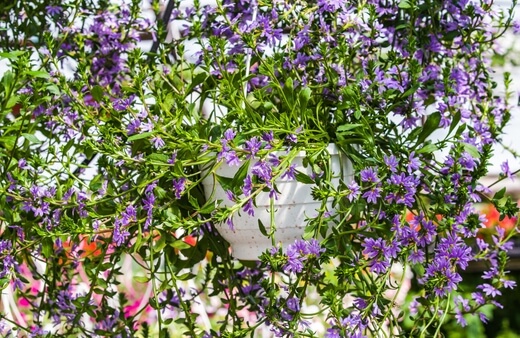
The Fan Flower is also known as the Aussie Crawl. It is a hardy plant that is great for making colourful hanging baskets. The plant features blue-mauve fan shaped flowers. Peak flowering times are in the spring, summer, and autumn with spotting between peak flowerings.
Fan flowers should be grown outdoors. In full sun to light shade. After peak blooming, the plant can be cut back halfway to encourage new growth. The hanging plants do not need to be deadheaded.
Fan Flowers do best in well-drained soil. Water during dry times. Fertiliser is not necessary. However, you can add a small amount in the summer.
17. Boston Fern (Nephrolepis exaltata)
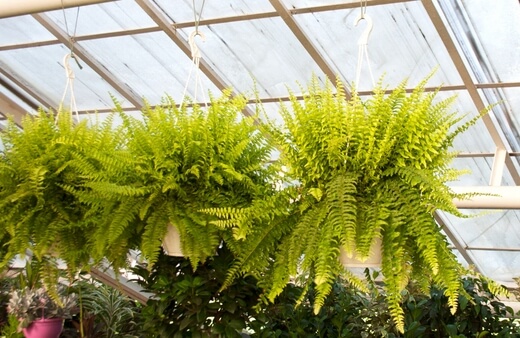
Boston ferns have deep, lush green drooping fronds with small leaves. They are attractive ferns that are perfect as hanging basket plants. They are fairly easy to care for. Boston ferns make great hanging plants.
Indoors, they need to be placed in a warm, well-lit area out of direct sunlight. Outdoors, they need to be in a warm, shady area. Prune in the winter to keep the plant tidy. Boston ferns grow best in well-drained, sandy soil.
The plants require regular watering once a month. Overwatering can cause the plant to rot. Fertiliser should be applied every other month.
18. Wax Plant (Hoya carnosa)

The Hoya Wax Plant is also known as the Porcelain Flower. It is a twining climber. The leaves are thick and mid-green colour. The plant produces half globe shaped flowers that look like wax. The flowers are often pink, but there are other colours available.
Wax plants do not grow well outside. They should be grown indoors in good light. The light should not be direct. The best times to prune wax plants are in the spring and summer.
Wax plants should be planted in a free draining soil mix. The soil should be kept moist, but not saturated. In the spring, add a 6 month controlled fertiliser. Do not fertilise in the winter.
19. Staghorn Fern (Platycerium spp.)
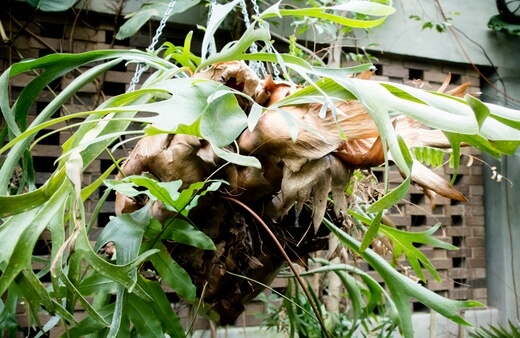
Staghorn ferns are gravity-defying plants. They got their name because they resemble antlers. The plants grow rather slower and can get quite big. They can be difficult to grow.
Staghorn ferns can be grown indoors and outdoors. They require partial sun. The ferns do not require regular pruning. They can tolerate heavy pruning.
Although Staghorn ferns are parasitic plants that naturally grow on tree trunks and limbs, they can be used as hanging plants. They grow very well in sphagnum moss and potting mix that is kept moist. Feed the plants once or twice a year using a diluted liquid fertiliser.
20. Golden Creeping Jenny (Lysimachia nummularia ‘Aurea’)
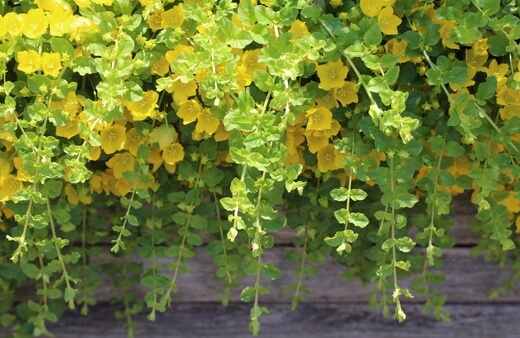
Golden Creeping Jenny is also known as Moneywort. They are vigorous, low growing plants with cascading rounded green leaves. The plant produces small yellow flowers.
Golden creeping jenny are outdoor hanging plants. They need to be placed in full sun. Regular pruning is not necessary. Before winter hits, trim back any dead stems.
Golden creeping jenny grows best in well-draining, sandy, loamy soil. They require regular waterings. The soil should not be allowed to dry out. Once established, fertiliser the plants in the spring using a 10-10-10 solution.
21. Convolvulus sabatius ‘Little Arctic Moon’

Little Arctic Moon is a creeping plant that is easy to grow. It is compact in size with a massive amount of small, saucer shaped white flowers. Convolvulus is an outdoor hanging plant. It should be hung where it will get full sun to partial shade. It does not require pruning.
Little Arctic Moon will grow in most well-draining soils. Once established, they require very little water. A slow release fertiliser should be applied in the spring.
22. Zebra Plant (Tradescantia zebrina)
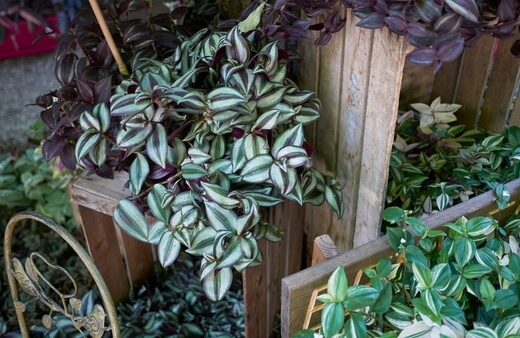
The Zebra Plant is also known as the Wandering Jew. It has colourful foliage which includes purples, silvers, and greens. It easily roots and can thrive in different environments. It can produce clusters of small, bright pink flowers.
Zebra plants grow well as indoor and outdoor hanging plants. They require full sun to partial shade. The plants grow quickly, so they need to be pruned regularly. After pruning, be certain to properly dispose of the trimmings. Zebra plants can take over areas quickly.
Zebra plants can grow in most moist well-drained soils. The plants require light watering to keep the soil moist. A weekly feeding of an all purpose fertiliser can be applied during the growing season.
23. Sutera cordata
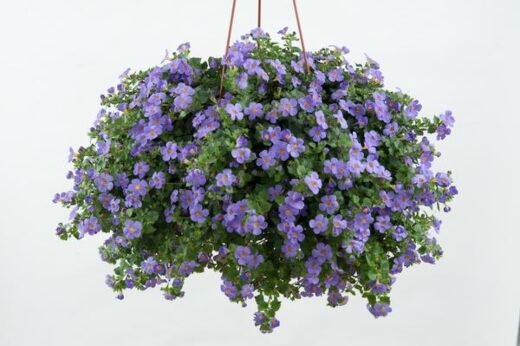
Source: Lucas Greenhouse
Sutera Blue Flowerburst has a neat evergreen foliage with spread and trail. It has dark green heart shaped leaves and small white to mauve flowers. The plant will produce flowers from summer to autumn.
Sutera Blue Flowerburst is an outdoor plant. It requires full sun to partial shades. It has more blooms in full sun. When overgrown, the plant can be lightly pruned. Deadheading is not necessary.
Sutera Blue Flowerburst will grow in all-purpose potting soil. The soil should be kept moist, but not wet. Every 2 to 3 weeks apply a water-soluble fertiliser.
24. Acalypha reptans
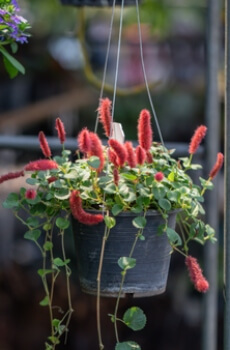
The Acalypha reptans is also known as the Dwarf Chenille. It is a showy plant with long, fuzzy red flowers. The flowers are produced periodically throughout the year. Acalypha reptans can be grown indoors and outdoors.
If grown outdoors, make sure to place it in full sun to partial shade. Indoors, it should get full to filtered light. Regular pruning is recommended to maintain shape. Acalypha reptans should be planted in a free draining, humus rich soil.
The soil should be kept moist. Watering is usually needed every 2 to 3 days. A liquid fertiliser can be applied monthly.
25. String Of Hearts (Ceropegia woodii)
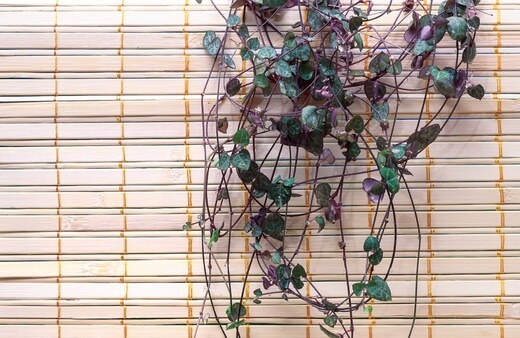
The String of hearts is also known as the Rosary Vine and Sweetheart Vine. It is a flowering plant with long vines. It is easy to care for and creates a dramatic focal point.
String of hearts can be grown indoors and outdoors. The plant should be placed in indirect light. Too much can burn the plant and stress it out. It can handle some morning sun. They benefit from occasional, light pruning.
String of hearts plants should be grown in a cactus and succulent mix soil. The plants require very little water. Overwatering can cause the plant to rot. The plants can be fertilised once a month. Be careful, too much fertiliser can cause damage.
Check out our guide to growing String of Hearts for more details.
26. Silver Dollar Vine (Xerosicyos danguyi)
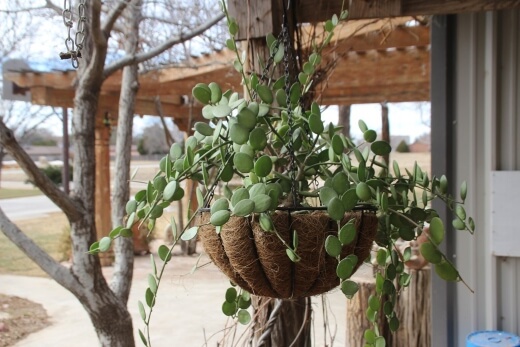
Source: Alice Liles
The Silver Dollar Vine has delicate tendrils that will grip onto a supporting structure. Even though it is a climbing plant, the vine can cascade over the side of a hanging basket. It has a small caudex at the base. The plant can produce clusters of yellow-green flowers during the spring and summer.
Silver dollar vines are not recommended as indoor plants. They need a few hours of direct sunlight every day. Pruning can be performed in the spring and summer.
Silver dollar vines grow in light, quick-draining soil. The plants should be watered monthly. A small amount of a high-quality slow-release fertiliser can be applied once a year.
27. Rhipsalis

Rhipsalis are a species of cactus. But unlike other cacti, they do not have spines and direct sunlight is not required. They also need lots of water. The long, draping cacti have intertwined stems.
Rhipsalis plants can be grown indoors all year and outdoors in the summer. They should be kept out of direct sunlight. Pruning is not required. Propagating can be performed with simple division.
In nature, the Rhipsalis does not require soil. However, when grown as hanging plants, plant them in a cactus potting mix. Getting the sunlight to water ratio can be difficult. Soil should be kept moist. If leaves are falling off, the plant is getting too much water. Feed every two weeks using a diluted fertiliser.
See our guide on how to grow and care for Rhipsalis for more details.
28. Donkey’s Tail (Sedum morganianum)

Donkey Tails are also known as the Burro’s Tail. Is a perfect plant for hanging baskets. The plant is not the easiest to care for. The plant is very fragile and can quickly drop its leaves.
Donkey tails can grow outside all year long in tropical climates. In cooler climates, the plants should be kept indoors. No pruning is necessary unless stems need to be removed due to lack of leaves.
Donkey tails need to be planted in a cacti or succulent soil mixture. For new plants, soil should be kept moist, but not saturated. Once established, reduce watering. Donkey tails do not have to be fertilised.
If you feel the plant needs to be fertilised use a diluted liquid solution up to twice a year. Do not fertilise in the winter.
29. Iberis sempervirens ‘Whiteout’
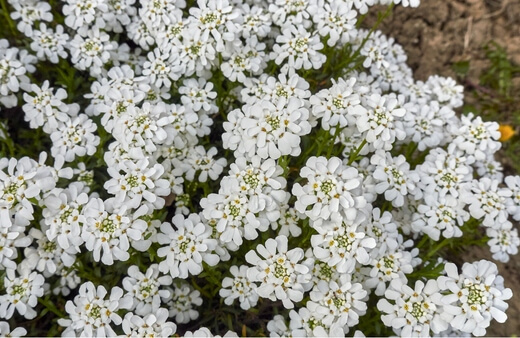
The Iberis ‘Whiteout’ is a low maintenance plant. Its soilage has a rich green colour. The plant produces clusters of white flowers. Iberis ‘Whiteout’ plants make beautiful outdoor hanging plants. Iberis ‘Whiteout’ are perfect for outdoors hanging baskets. They need to be placed in full sun. Pruning is not generally required.
Iberis ‘Whiteout’ can grow in most types of well-draining soil. The soil should be kept moist at all times. Once the main flowering is complete, feed it with a slow-release fertiliser.
30. Spider Plant (Chlorophytum comosum)

Spider plants have one to several small tubers and long thin, narrow leaves. The leaves are a vibrant green with white or yellow streaks. Spider plants thrive indoors with very little care. They only need medium light and should not be placed in direct sunlight.
Pruning is not required but is recommended to reduce plant size. Spider plants need well drained soil. The soil should be kept moist, but not saturated. They can tolerate dry soil for short periods of time. Fertiliser is not required, but you can apply a controlled-release fertiliser if you like.
Read our guide on how to grow and care for Spider plants for more details.
31. Brunoniella pumilio ‘Little Blue Trumpets’
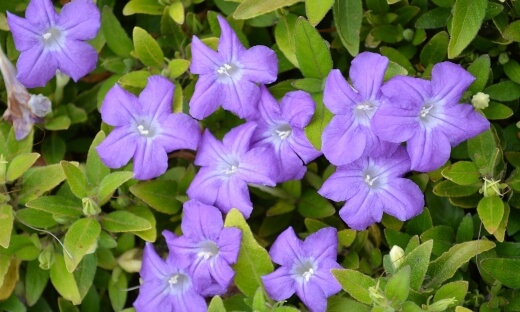
Source: Plant Growers Australia
Brunoniella ‘Little Blue Trumpets’ are also known as Dwarf Blue Trumpets. They are low maintenance hanging plants that are easy to grow. The sprawling plants that have long, elliptical green leaves and blue to mauve flowers.
Brunoniella ‘Little Blue Trumpets’ are for outdoor use. They can be grown in full sun to partial shade. Normal pruning is not required. They grow best in water-retentive sandy soils.
Once the plants are established, they need an occasional long soaking. A slow-release fertiliser can be applied in the spring.
32. Creeping Greenie (Glechoma hederacea)
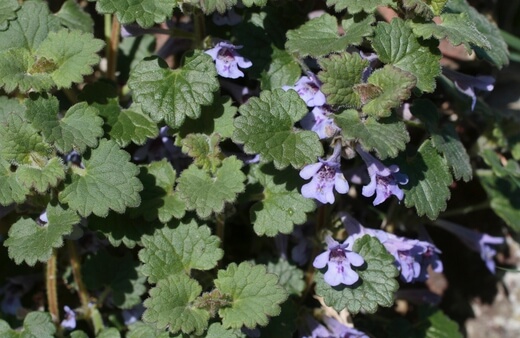
The Creeping Greenie is a low growing perennial. It has bright green, round leaves with scalloped edges. In the spring, it can produce small, lavender coloured flowers.
Creeping greenie is great for adding colour to low light areas. It can grow in full sun to partial shade. Pruning is only required when the plant needs to be shaped. Creeping greenie grows best in moist, well-draining soil. It needs regular watering. Add a slow-release fertiliser in the spring.
33. Pansies (Viola tricolor var. hortensis)
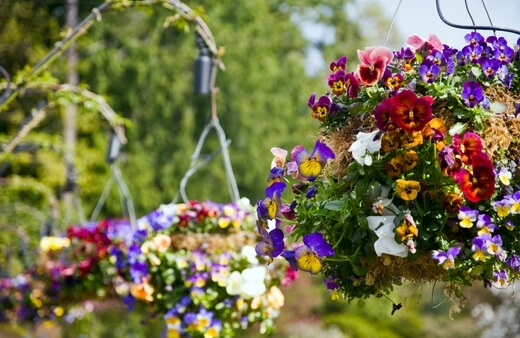
Pansies are low growing perennials. Their leaves are green, while the flowers come in a multitude of colours. The petals of the flowers are often striped or spotted. Pansies make beautiful outdoor hanging plants.
During the cooler months they prefer sunny spots. During the hotter months, they prefer a light shade. Pruning is not usually required. Simply deadhead the blooms. Pansies grow best outside in well-drained, fertile garden soil. The soil should be kept moist.
A controlled release fertiliser should be applied at the initial planting. After that, a monthly feeding of a water-soluble fertiliser is recommended. Consecrated granular fertilisers should not be placed in contact with the roots.
34. Carex oshimensis ‘Feather Falls’
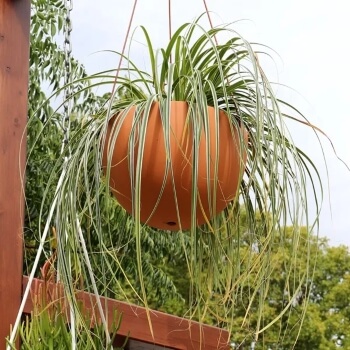
Source: Warners Nurseries
Carex ‘Feather Falls’ has bright green glossy foliage with creamy white borders. Once established, it requires very little care. Carex ‘Feather Falls’ are outdoor plants that look amazing when used as hanging plants. They will grow in full sun to full shade. They do not require pruning.
Carex ‘Feather Falls’ will grow at a medium rate in well-drained soil. They can tolerate wet and dry soil. For the best results, the soil should be kept moist. You can use a slow-release fertiliser. However, the plants are sensitive to over fertilisation.
35. Heart-Leaf Philodendron (Philodendron hederaceum)
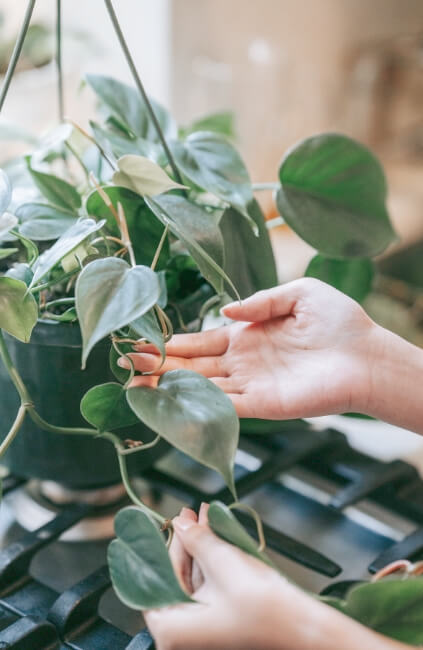
Heart-leaf Philodendron is also known as the sweetheart plant. It has heart-shaped evergreen foliage. It is a slow growing plant that is easy to propagate. Heart-leaf philodendron plants are cold sensitive.
They should only be grown indoors unless you live in a tropical climate. Regular pruning should be performed to tame the plant and promote new growth. Heart-leaf philodendron grown as hanging plants should be planted in a soilless potting mix with peat moss. Fertilise occasionally using a slow-release fertiliser.
(We used to advocate for peat/sphagnum moss. But, recognizing its environmental impact, we've transitioned our guidance toward eco-conscious alternatives that offer comparable or better benefits. Check out our informative guide to learn more about peat moss and its substitutes.)
36. Arrowhead Plant (Syngonium podophyllum)
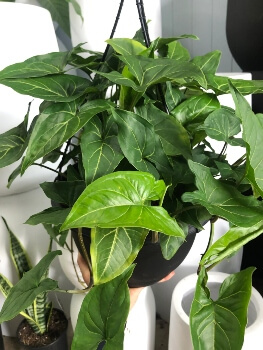
The Arrowhead Plant is a vine with arrowhead shaped leaves when it is young. As the plant matures, the leaves become more hand shaped. It is a very easy plant to care for.
Arrowhead plants are indoor hanging plants. They require bright, indirect light. Regular pruning is needed to create a full, bushy plant. For an arrowhead plant to flourish, it needs to be planted in a mix of garden soil, sand, vermicompost, and coco peat.
The plants require very little water during the cooler months. During the warmer months, the soil should be kept moist. Arrowhead plants should only be fertilised when actively growing using diluted liquid fertiliser.
37. Fuchsia
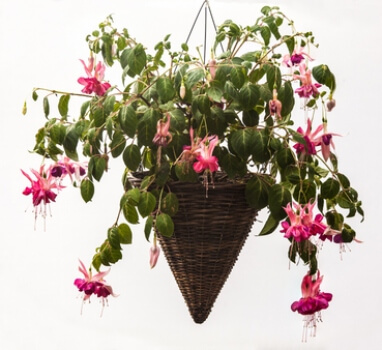
Fuchsias are wonderful plants for hanging baskets. They have deep green leaves and loads of showy flower clusters from late spring through early winter. Fuchsias love to be outside in partial sun to full shade.
They should be placed in an area that protects them from the wind. It can be pruned regularly to promote new growth. They should also have a light pruning just after flowering.
Fuchsias should be planted in rich, well-draining soil. They require regular watering. Since fuchsias are naturally rapid growing plants, they do not require regular fertilising.
38. Ruby Necklace (Othonna capensis)

Ruby Necklace is a succulent plant that is ideal for hanging baskets. It is an easy plant to grow. The leaves have a bean like shape and the stems are ruby coloured. The plant can produce small, bright yellow flowers throughout the year.
Ruby necklace grows best indoors in indirect sunlight. A little bit of morning sun will help the plant stay vibrant. Pruning can be done when you want to propagate new plants.
Ruby necklace hanging plants need to be planted in well-draining soil. Wet soil will lead to root rot. The soil should be allowed to dry before watering. Fertiliser can be used once or twice a year.
39. Codonanthe
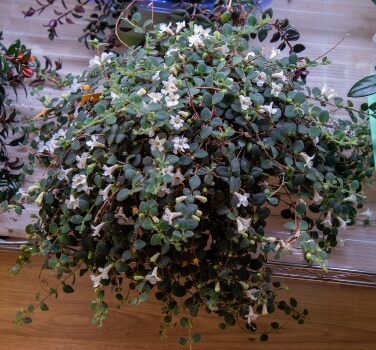
Source: Gesneriad Reference Web
Codonanthe are a rare plant in the violet family. Since they are in the violet family, they can be hard to grow for some people. If they get too little water or too much water, they will die. The plants have small, shiny rounded leaves and tiny white flowers.
Codonanthe plants are for indoor hanging baskets. They need high light. Regular pruning is not necessary unless the plant needs to be rejuvenated. Codonanthe hanging plants require a special organic rich orchid mix soil.
They require regular medium watering, but you should let the top of the soil dry out first. The plants hate waterlogged soil. To keep the plant moist, mist it often with a hand spray bottle. The plants should be fertilised in the spring and summer using houseplant fertiliser.
40. Verbena ‘Purple Passion’
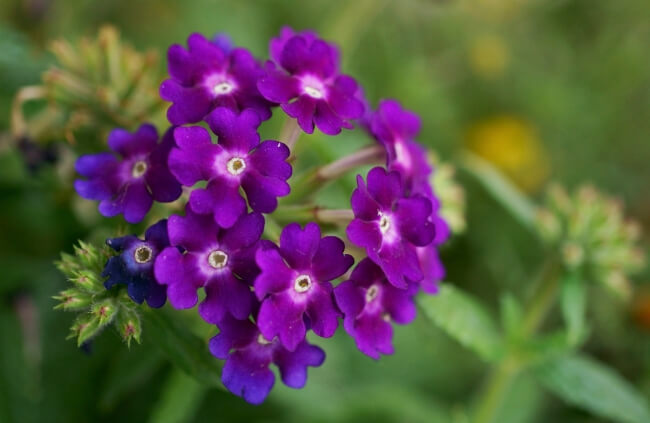
Verbena are attractive hanging plants that have dark green foliage. It grows extremely fast. It features clusters of blossoms from summer to the first frost. Flowers can range anywhere from white, pink, blue-violet, lavender, to salmon.
Verbena is an outdoor plant. They can thrive in full sun to partial shade. Deadheading is not required. Instead, if the plant gets ragged, trim it back to half its size. Verbena plants need a well-drained moist soil. They are fairly drought tolerant and only require occasional watering. To boost the number of flowers, fertilise regularly.
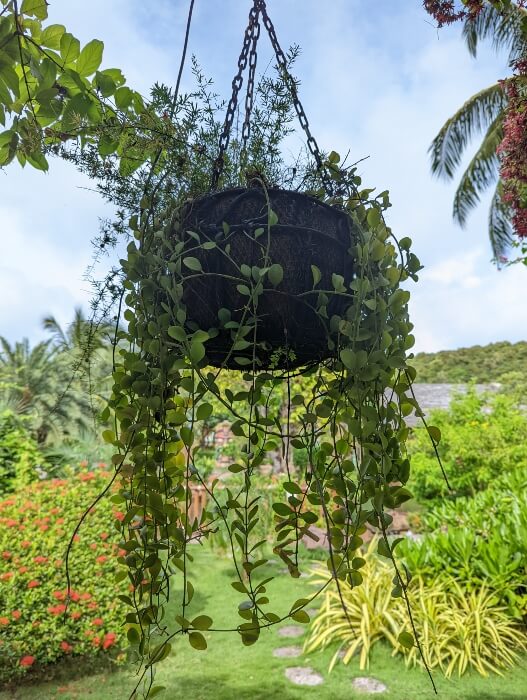
For more collections of types of plants, refer to our list below:
Wrapping Up Our List of Hanging Plants
Beautiful hanging baskets do not need to take up a lot of your time. Watering, fertilising, and pruning should be quick and easy. Choosing hanging plants that are too difficult to care for takes the fun out of growing plants.
Published on March 6, 2023 by Maisie Blevins
Last Updated on September 20, 2024




